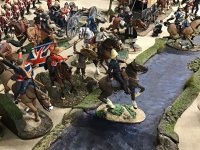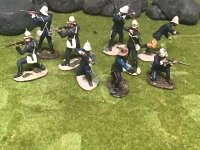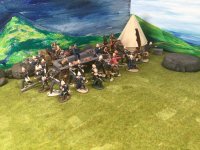- Joined
- Feb 2, 2011
- Messages
- 2,350
JJDESIGNS NEWS UPDATE 23rd SEPTEMBER 2024
THE ANGLO ZULU WAR
THE BATTLE OF GINGINDHLOVU, 2nd APRIL 1879.
The Battle of Gingindhlovu was fought on 2nd April 1879 between a British relief column sent to break the siege at Eshowe, and a Zulu impi of king Cetshwayo.
The British soldier would refer to it as the Battle of “GIN GIN I LOVE YOU”.
Charles Pearson had led No.1 column of the British invasion force across the Tugela River to establish an advanced base at Eshowe. Having set up a base at a deserted Norwegian mission station, the British found themselves besieged.
A relief column was organized by Lord Chelmsford and departed Fort Tenedos on 29th March to relieve the garrison.
Chelmsford’s relief force comprised 3,390 Europeans, and 2,280 Africans.
BRITISH STRATEGY
Due to the rocky terrain of Zululand and the ponderous progress of ox drawn supply wagons, the British invasion force would be very slow moving. Ordinarily, such serious transport deficiencies would have been a serious handicap, but Chelmsford turned this slow progress to his tactical advantage.
Lord Chelmsford ensured his men spent much time laagering and entrenching their camp at the end of each day, and kept ammunition boxes open and at the ready.
A measured advance towards the Zulu capital of Ulundi permitted both adequate reconnaissance of uncharted Zululand and allowed the progressive destruction of Zulu crops and villages as his invasion force advanced, actions calculated to provoke the Zulus into attacking his prepared squares or entrenched positions.
The standard battle tactic employed by the British in South Africa was a combination of good reconnaissance followed by ruthless skirmishing. In rough country, both the infantry and cavalry would advance to meet the enemy, the infantry breaking up any established groups and the cavalry harassing them in flight. If the Zulus appeared in any number, the British were trained to form a square or entrench their position, thus drawing the Zulus into the range of their overwhelming firepower.
Well aimed rifle volley fire, supported by rockets, artillery and later in the campaign, Gatling guns, would in Chelmsford’s view, ensure the invincibility of the invasion force.
Once a Zulu attack on such a well defended position faltered, the cavalry would leave the protection of the entrenched position to harass and rout the attackers.
MOUNTED INFANTRY
At the beginning of the campaign Chelmsford had no regular cavalry regiments at his disposal, which was a setback given the cavalry traditional role of scouting and pursuit.
He did however have two understrength squadrons of Mounted Infantry, who were distributed throughout the invading columns.

The Mounted Infantry consisted of selected soldiers from infantry regiments mounted on locally acquired horses.

During the Zulu war the men of the mounted infantry, chosen from nearly every infantry battalion, wore their regiment’s tunic, cord breeches and riding boots.
They were armed with Martini-Henry rifles, and instead of the usual infantry equipment carried a bandolier.

Despite the mixed origins of this Mounted Infantry force, it performed extremely well, and paved the way for greater reliance on Mounted Infantry units in later campaigns.

Major P. H. S. Barrow was to command the 70 Mounted Infantry at Gingindhlovu, and had armed the men with sabres.

NATAL NATIVE HORSE
The Natal Native Horse was formed in 1879, from Natal Bantu, and they rode their own ponies and served as scouts and transport men.
The ranks were mainly filled by Christians from the Edendale and Dreifontein Missions.
Three of the troops were drawn from the amaNgwane clan, who lived in the Drakensburg foothills in Natal, and were old enemies of the Zulus.
All of the NNH wore European clothing and had a red rag round their hats. Most preferred to ride barefoot, with their toes grasping the stirrup, but the Edendale men were booted and spurred.
All were armed with carbines, and some carried hide quivers of assegais.

There were five troops of Natal Native Horse at Isandhlwana, all under Captain W. Barton, and from contemporary accounts they did their work particularly well. At Isandhlwana they fought their way through the encircling Zulus and lined the far bank of the Buffalo river to cover the flight of the survivors.
If well led and intelligently employed, the Natal Native Horse excelled at their primary duties of scouting and mopping up after a battle.
They were never intended as a front line force.
At Gingindhlovu there was 1 troop of Natal Native Horse present, along with Jantzi’s Native Horse which were also part of the Natal Native Horse.
Mafunzi’s Mounted Natives, was also a mounted unit, raised in 1879 with a strength of 73 men. They were to serve with the 1st Division during the Zulu War.
Please note the Zulus will be previewed next year.
Best wishes,
john jenkins
THE ANGLO ZULU WAR
THE BATTLE OF GINGINDHLOVU, 2nd APRIL 1879.
The Battle of Gingindhlovu was fought on 2nd April 1879 between a British relief column sent to break the siege at Eshowe, and a Zulu impi of king Cetshwayo.
The British soldier would refer to it as the Battle of “GIN GIN I LOVE YOU”.
Charles Pearson had led No.1 column of the British invasion force across the Tugela River to establish an advanced base at Eshowe. Having set up a base at a deserted Norwegian mission station, the British found themselves besieged.
A relief column was organized by Lord Chelmsford and departed Fort Tenedos on 29th March to relieve the garrison.
Chelmsford’s relief force comprised 3,390 Europeans, and 2,280 Africans.
BRITISH STRATEGY
Due to the rocky terrain of Zululand and the ponderous progress of ox drawn supply wagons, the British invasion force would be very slow moving. Ordinarily, such serious transport deficiencies would have been a serious handicap, but Chelmsford turned this slow progress to his tactical advantage.
Lord Chelmsford ensured his men spent much time laagering and entrenching their camp at the end of each day, and kept ammunition boxes open and at the ready.
A measured advance towards the Zulu capital of Ulundi permitted both adequate reconnaissance of uncharted Zululand and allowed the progressive destruction of Zulu crops and villages as his invasion force advanced, actions calculated to provoke the Zulus into attacking his prepared squares or entrenched positions.
The standard battle tactic employed by the British in South Africa was a combination of good reconnaissance followed by ruthless skirmishing. In rough country, both the infantry and cavalry would advance to meet the enemy, the infantry breaking up any established groups and the cavalry harassing them in flight. If the Zulus appeared in any number, the British were trained to form a square or entrench their position, thus drawing the Zulus into the range of their overwhelming firepower.
Well aimed rifle volley fire, supported by rockets, artillery and later in the campaign, Gatling guns, would in Chelmsford’s view, ensure the invincibility of the invasion force.
Once a Zulu attack on such a well defended position faltered, the cavalry would leave the protection of the entrenched position to harass and rout the attackers.
MOUNTED INFANTRY
At the beginning of the campaign Chelmsford had no regular cavalry regiments at his disposal, which was a setback given the cavalry traditional role of scouting and pursuit.
He did however have two understrength squadrons of Mounted Infantry, who were distributed throughout the invading columns.

The Mounted Infantry consisted of selected soldiers from infantry regiments mounted on locally acquired horses.

During the Zulu war the men of the mounted infantry, chosen from nearly every infantry battalion, wore their regiment’s tunic, cord breeches and riding boots.
They were armed with Martini-Henry rifles, and instead of the usual infantry equipment carried a bandolier.

Despite the mixed origins of this Mounted Infantry force, it performed extremely well, and paved the way for greater reliance on Mounted Infantry units in later campaigns.

Major P. H. S. Barrow was to command the 70 Mounted Infantry at Gingindhlovu, and had armed the men with sabres.

NATAL NATIVE HORSE
The Natal Native Horse was formed in 1879, from Natal Bantu, and they rode their own ponies and served as scouts and transport men.
The ranks were mainly filled by Christians from the Edendale and Dreifontein Missions.
Three of the troops were drawn from the amaNgwane clan, who lived in the Drakensburg foothills in Natal, and were old enemies of the Zulus.
All of the NNH wore European clothing and had a red rag round their hats. Most preferred to ride barefoot, with their toes grasping the stirrup, but the Edendale men were booted and spurred.
All were armed with carbines, and some carried hide quivers of assegais.

There were five troops of Natal Native Horse at Isandhlwana, all under Captain W. Barton, and from contemporary accounts they did their work particularly well. At Isandhlwana they fought their way through the encircling Zulus and lined the far bank of the Buffalo river to cover the flight of the survivors.
If well led and intelligently employed, the Natal Native Horse excelled at their primary duties of scouting and mopping up after a battle.
They were never intended as a front line force.
At Gingindhlovu there was 1 troop of Natal Native Horse present, along with Jantzi’s Native Horse which were also part of the Natal Native Horse.
Mafunzi’s Mounted Natives, was also a mounted unit, raised in 1879 with a strength of 73 men. They were to serve with the 1st Division during the Zulu War.
Please note the Zulus will be previewed next year.
Best wishes,
john jenkins

















